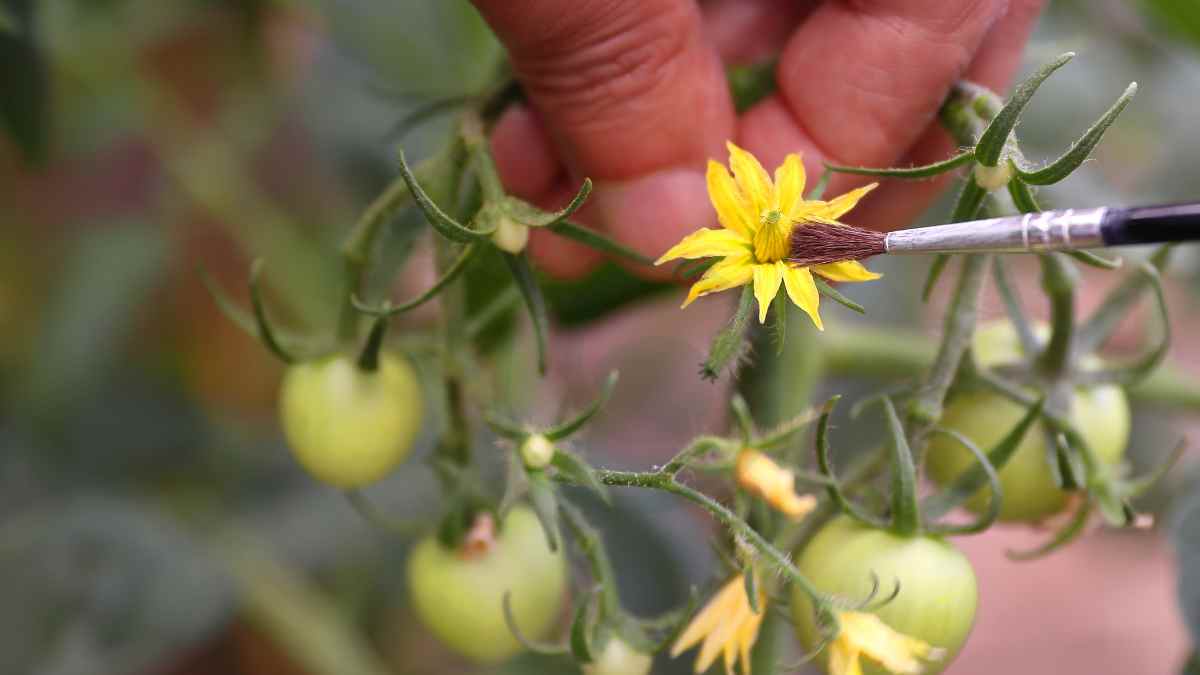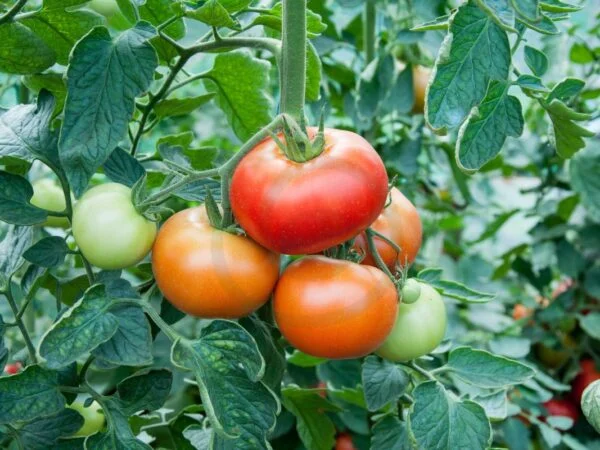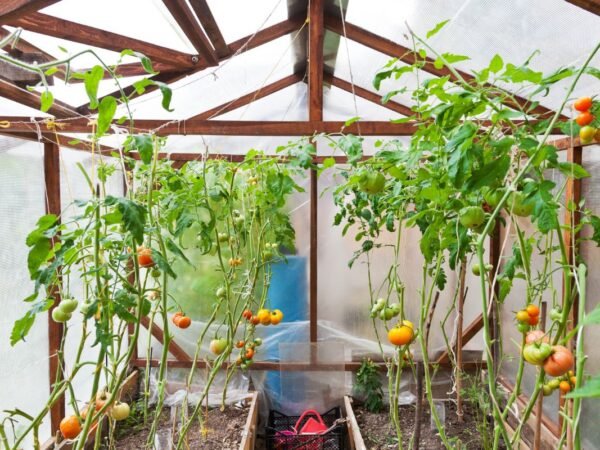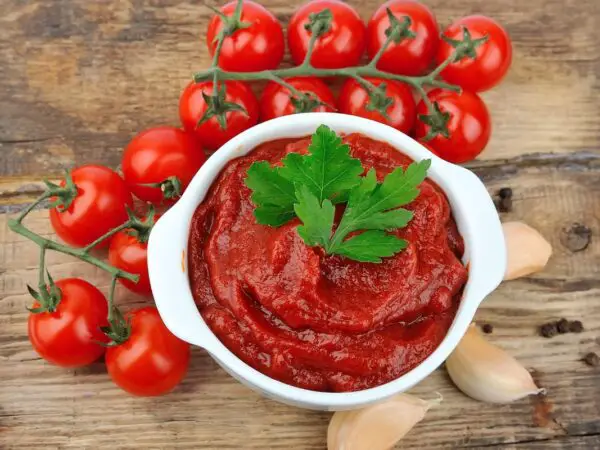Tomato plants can indeed cross-pollinate, but the extent of this occurrence depends on various factors such as the proximity of different tomato varieties, the presence of pollinators, and the structure of the garden or field where they are grown. Understanding the mechanisms of cross-pollination can help gardeners manage their tomato crops effectively.
In general, tomato plants are self-pollinating, as they possess both male and female reproductive organs within the same flower. However, they can also be cross-pollinated by insects, wind, or human intervention. This can lead to the exchange of genetic material between different varieties, potentially altering the characteristics of future generations. To prevent unwanted cross-pollination, gardeners often separate tomato varieties by distance or employ physical barriers such as isolation cages or hand pollination techniques.
For further insight into managing cross-pollination in tomato plants and optimizing yield, exploring techniques such as selective breeding, genetic studies, and pollination control methods can offer valuable strategies for achieving desired results in tomato cultivation. Understanding the dynamics of pollination can empower gardeners to make informed decisions about their plantings and contribute to the preservation and enhancement of tomato diversity.
Key Takeaways
- Understand how cross-pollination happens to prevent unintended mixing of tomato plant varieties.
- Identify signs of cross-pollination, such as changes in fruit characteristics or unexpected plant traits.
- Take proactive steps to prevent cross-pollination, like isolating different tomato varieties or planting them at a distance.
- Utilize techniques for isolation, such as using physical barriers or timing plantings strategically.
- Be aware of the effects cross-pollination can have on yield and quality, affecting future harvests with seeds and tomato flowers.
- Emphasize the importance of prevention to maintain the purity and desired traits of tomato plants.
Cross-Pollination Basics
Natural Process
Tomato plants primarily self-pollinate through the transfer of pollen within the same flower. However, in rare instances, cross-pollination can occur when pollen is transferred between different tomato plants. The perfect flowers of tomato plants, containing both male and female reproductive parts, facilitate this pollination process.
Tomato Plant Biology
The anatomy of tomato plants' perfect flowers plays a crucial role in their pollination. These flowers possess both male stamens that produce pollen and female pistils that receive pollen for fertilization. Unlike many other plant species, tomato plants are not typically insect or wind-pollinated, relying more on self-pollination mechanisms.
Pollination Agents
Insects such as bees and butterflies can inadvertently play a part in cross-pollination among tomato plants. As they move from flower to flower collecting nectar, these insects may unknowingly transfer pollen between different tomato plants. This unintentional transfer can impact the genetic diversity and future growth of tomato plants.
How Cross-Pollination Occurs
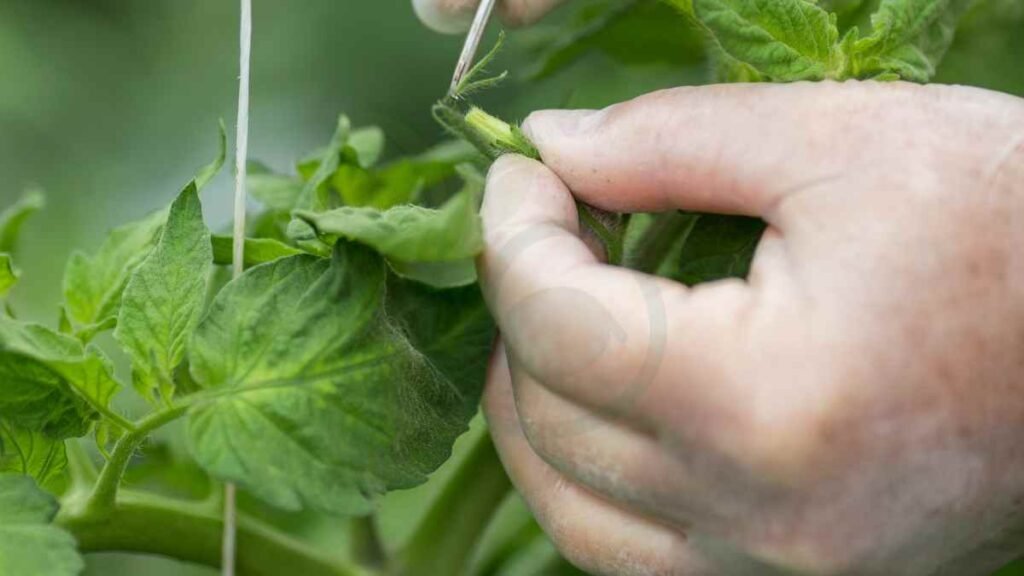
Wind and Insects
Wind plays a crucial role in cross-pollination for tomato plants. It aids in the transfer of pollen between plants, promoting genetic diversity. Insects, like bees, also contribute to this process by carrying pollen from one plant to another.
Understanding how wind affects the transfer of pollen is essential. Strong winds can carry pollen over long distances, increasing the chances of cross-pollination. However, excessive wind can lead to pollen loss, affecting the pollination process.
The interaction between insects and wind is vital for successful pollination in tomato plants. Bees are efficient pollinators that complement the work of the wind, enhancing the overall pollination process. Their combined efforts result in better fruit set and yield.
Human Intervention
Following guidelines for seed preservation is crucial to prevent unwanted cross-pollination. Growers of heirloom plants must take specific measures to maintain the genetic integrity of their crops. This involves isolating different varieties to avoid unintended cross-breeding.
Growers play a significant role in preventing cross-pollination through human intervention. By carefully planning and managing their crops, they can control which plants breed with each other. This ensures that desired traits are preserved and passed on without interference from other varieties.
Maintaining genetic purity in tomato plants requires attention to detail and adherence to best practices. By understanding the impact of human intervention, growers can safeguard the integrity of their crops and ensure consistent quality year after year.
Identifying Cross-Pollination
Plant Characteristics
Tomato plants have unique characteristics like perfect flowers with both male and female parts. These plants rely on wind, insects, or human intervention for pollination. The structure of the flower plays a crucial role in determining the likelihood of cross-pollination occurring. For instance, the anther and stigma positions within the flower can influence the transfer of pollen.
The height of tomato plants also affects cross-pollination as taller plants are more likely to be cross-pollinated by insects flying between them. The timing of flowering is essential; if different varieties bloom simultaneously, cross-pollination can easily occur. Understanding these plant-specific traits is vital in managing and preventing unwanted cross-pollination in tomato crops.
Fruit Variations
Cross-pollination can result in variations in tomato fruits, impacting their size, shape, color, and taste. When pollen from one variety fertilizes another variety's flowers, it introduces genetic diversity that manifests in the resulting fruits. This diversity can lead to unexpected changes in fruit characteristics compared to the parent plants.
The influence of cross-pollination on fruit characteristics is significant for commercial growers aiming to maintain consistent fruit quality. Changes in fruit size due to cross-pollination may affect marketability and consumer preferences. Moreover, alterations in taste profiles resulting from cross-pollination can either enhance or diminish the desirability of the fruits.
Preventing Cross-Pollination
Blossom Bagging
Materials Needed
- Blossom bags: essential for covering tomato flowers to prevent cross-pollination.
- Breathable fabric: used in blossom bags to allow air circulation while protecting the flowers.
- String or twist ties: necessary for securing the blossom bags around the tomato flowers.
Step-by-Step Guide
- Place a blossom bag over a tomato flower before it opens to protect it from cross-pollination.
- Secure the bag around the flower using string or twist ties, ensuring it stays in place.
- Repeat this process for each tomato flower you want to safeguard from cross-pollination.
Physical Barriers
- Blossom bags: act as physical barriers to prevent insects from transferring pollen between tomato plants.
- Protective enclosures: can also be used as physical barriers to isolate tomato plants and avoid cross-pollination.
Timed Planting
- Planting tomatoes at different times can help prevent unintended crossbreeding.
- By staggering planting schedules, you can ensure that different varieties of tomatoes do not flower simultaneously.
Techniques for Isolation
Spatial Separation
Spatially separating different tomato varieties is crucial to prevent unintended crossbreeding. By maintaining a distance between plants, you can ensure that each variety remains genetically pure. This separation helps in preserving the unique characteristics of each tomato type.
Understanding the benefits of spatial separation is essential for successful tomato cultivation. It allows each plant to grow without interference from other varieties, reducing the risk of cross-pollination. By strategically placing different types of tomatoes apart, you can safeguard their distinct traits.
The importance of distance between tomato plants cannot be overstated when aiming to avoid cross-pollination. Adequate spacing ensures that pollen from one variety does not reach another, preserving the purity of each plant. This technique is fundamental for maintaining genetic integrity in tomato crops.
Barrier Methods
Various barrier methods can effectively prevent cross-pollination in tomato plants. Using physical barriers such as mesh covers or bags over flowers can isolate individual plants and prevent pollen transfer between them. These techniques are particularly useful for heirloom or hybrid varieties.
Exploring the effectiveness of different barrier techniques is essential for choosing the most suitable method for your tomato plants. Barrier methods not only protect against crossbreeding but also help in controlling pests and diseases. Implementing these barriers can significantly improve crop yield and quality.
Barrier methods play a crucial role in maintaining pure tomato strains by preventing unwanted pollination events. Whether using isolation cages or hand pollination, these techniques ensure that each plant retains its unique genetic makeup. By incorporating barrier methods, growers can preserve the integrity of their tomato varieties.
Genetic Resistance
Understanding genetic resistance in tomato plants is key to preventing cross-pollination. Certain genetic traits make some varieties less susceptible to external pollen, reducing the chances of unintended hybridization. Selecting resistant cultivars is a proactive approach to safeguarding genetic purity.
Genetic resistance plays a significant role in ensuring that cross-pollination does not compromise the integrity of tomato varieties. By breeding plants with specific resistance traits, growers can minimize the risk of contamination from neighboring plants. This strategy is vital for preserving heirloom and specialty tomatoes.
The importance of genetic traits cannot be underestimated when aiming to maintain pure tomato varieties. Traits such as self-pollination mechanisms or pollen incompatibility are valuable in preventing unwanted hybridization events. By selecting tomatoes with desirable genetic characteristics, growers can sustain the authenticity of their crops.
Effects on Yield and Quality
Fruit Size
Cross-pollination can influence the size of tomato fruits by introducing genetic diversity. This process results in variations in fruit size due to the combination of different parent plants' traits. The impact of pollination on the development of tomato fruits is significant, as it directly affects their final size.
Understanding how cross-pollination can affect fruit size is crucial for farmers and gardeners looking to cultivate tomatoes with specific characteristics. By comprehending the potential variations in size, growers can better plan and manage their crops to achieve desired outcomes. The role of pollination in determining fruit size underscores its importance in agricultural practices.
Taste Variation
The influence of cross-pollination on the taste of tomato fruits can lead to significant variations in flavor profiles. When different varieties cross-pollinate, the resulting fruits may exhibit unique taste characteristics not present in either parent plant. This phenomenon highlights how pollination plays a key role in shaping the overall taste experience of tomatoes.
For consumers and food enthusiasts, understanding how crossbreeding can affect taste is essential for selecting tomatoes that align with their preferences. By learning about the potential variations in taste due to cross-pollination, individuals can make informed decisions when purchasing or growing tomatoes. The connection between pollination and flavor underscores the intricate relationship between genetics and sensory perception.
Seed Viability
Exploring the viability of seeds produced through cross-pollination reveals insights into genetic diversity and quality. Cross-pollination can impact seed quality by introducing new genetic combinations that may enhance or alter traits in subsequent generations. Factors such as pollen sources, environmental conditions, and breeding objectives influence seed viability in tomato plants.
Understanding how cross-pollination influences seed viability is crucial for breeders and researchers seeking to develop resilient and high-performing tomato varieties. By recognizing the factors that affect seed quality, experts can optimize breeding programs for desirable outcomes. The complex interplay between genetics, pollination, and environmental factors shapes the viability of seeds produced through crossbreeding processes.
Importance of Prevention
Seed Saving
Proper seed-saving techniques are crucial to prevent cross-pollination in tomato plants. By saving seeds correctly, you maintain the genetic integrity of each variety. This process ensures that future generations of tomatoes remain true to their original form.
To save seeds effectively, isolate different tomato varieties to avoid accidental cross-pollination. This method safeguards the purity of each plant's genetic makeup and prevents unwanted hybridization. By following these steps, you can preserve the unique characteristics of each tomato variety.
Pure Strains Maintenance
Maintaining pure tomato strains requires consistent efforts to prevent cross-pollination with other varieties. Challenges arise in ensuring genetic purity due to the natural tendency of plants to cross-pollinate. However, by implementing strict isolation measures, you can protect the integrity of pure tomato strains.
It is essential to monitor your tomato plants regularly to detect any signs of unintended cross-pollination. By staying vigilant and taking proactive measures, you can safeguard the purity of your tomato varieties and prevent unwanted hybridization from compromising their genetic makeup.
Advanced Prevention Strategies
Controlled Pollination
Controlled pollination in tomato plants involves manually transferring pollen from one flower to another. This method ensures specific parentage and prevents unintended cross-pollination, maintaining genetic purity. By controlling the pollination process, growers can dictate which plants breed together, preserving desired traits.
Grafting Techniques Grafting is a technique where the stem of one plant is attached to the root system of another. In tomato cultivation, grafting helps prevent cross-pollination by ensuring that only desired varieties reproduce. Using grafting techniques allows growers to control the genetic makeup of their tomato crops effectively.
Case Studies and Examples
Successful Isolation
Successful isolation techniques play a crucial role in preventing cross-pollination among tomato plants. By isolating different varieties, you can ensure pure strains. These methods involve physical barriers like nets or distance between plants.
- Physical barriers, such as nets, prevent the transfer of pollen between tomato plant varieties.
- Maintaining a significant distance between different types of tomato plants is another effective isolation method.
Isolation techniques are essential to safeguard the genetic integrity of tomato varieties. Without proper isolation, crossbreeding can occur, leading to hybrid tomatoes with altered characteristics.
Unintended Crossbreeding
Unintended crossbreeding in tomato plants can have detrimental effects on their genetic makeup. When different varieties cross-pollinate accidentally, it results in hybrid tomatoes with unpredictable traits. This can impact the overall genetic diversity of tomato crops.
- Accidental cross-pollination poses risks by altering the desired traits of specific tomato varieties.
- Unintentional crossbreeding can lead to the loss of pure strains and affect the quality of future harvests.
Maintaining distinct varieties through successful isolation is crucial for preserving the unique characteristics and flavors of various tomato types. Unintended crossbreeding can jeopardize these qualities and result in undesirable outcomes for growers.
Final Remarks
By understanding the intricacies of cross-pollination in tomato plants, you can take proactive steps to prevent unwanted hybridization and safeguard the quality and yield of your crops. Identifying the signs of cross-pollination early on and implementing isolation techniques are key strategies to maintain the purity of your tomato varieties. Remember, prevention is always better than correction when it comes to preserving the genetic integrity of your plants.
As you delve into your gardening endeavors, keep in mind the importance of staying vigilant against cross-pollination. Implement the advanced prevention strategies discussed here and monitor your plants closely for any signs of hybridization. Your efforts will not only ensure a bountiful harvest but also contribute to the preservation of unique tomato varieties for future generations.
Frequently Asked Questions
Do tomato plants cross-pollinate naturally?
Yes, tomato plants can cross-pollinate naturally through wind, insects, or human intervention. It is essential to understand the process to prevent unintended crossbreeding.
How can I identify cross-pollination in my tomato plants?
Look for characteristics like changes in fruit color, shape, or size inconsistent with the parent plant. Keep records of plant varieties and observe any variations that may indicate cross-pollination.
What are effective techniques for isolating tomato plants to prevent cross-pollination?
Use physical barriers like mesh bags or cages to isolate plants. Time planting strategically to avoid overlapping flowering periods between different varieties.
Will preventing cross-pollination affect the yield and quality of tomatoes?
Preventing cross-pollination helps maintain the purity of tomato varieties, ensuring consistent traits. It can lead to higher-quality fruits with desired characteristics and better control over seed saving.
Why is it important to prevent unintended cross-pollination in tomato plants?
Preventing unintended cross-pollination preserves the genetic integrity of tomato varieties. It ensures reliable seed saving, consistent crop quality, and prevents unexpected outcomes in future plant generations.
Image Source: Paid image from CANVA

